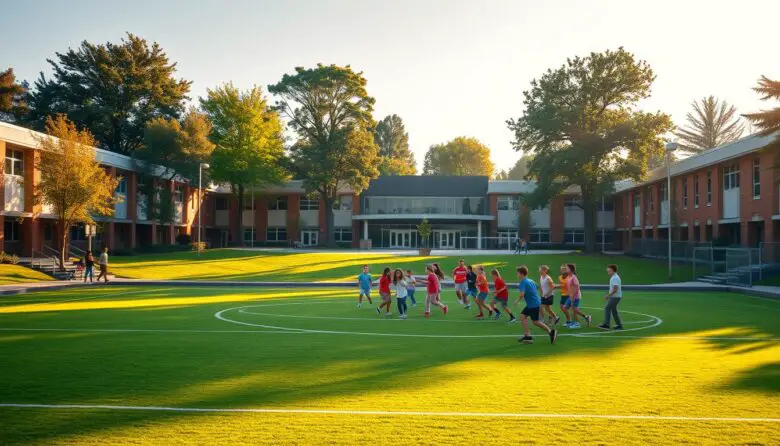Did you know that over 3,900 new positions are expected to open up in the next 10 years for professionals in this field? The US offers a wide range of opportunities, especially in areas like Maryland, where the median salary is $61,322 per year. With a growing focus on health and wellness, the demand for skilled individuals is higher than ever.
Choosing the right program and certification can make a significant difference in your career. Whether you’re looking to work in a school district or explore other paths, this guide will help you navigate the options. From education requirements to integrating technology, we’ll cover everything you need to know to succeed.
Key Takeaways
- Over 3,900 new positions are expected in the next decade.
- Maryland offers the highest median salary at $61,322 per year.
- Program selection and certification are crucial for success.
- Technology integration is becoming essential in this field.
- Competitive salaries are available across various states.
Introduction to Physical Education Teaching Opportunities
Promoting health and fitness in schools is more important than ever. With 95% of U.S. schools offering gym classes, the role of a gym instructor is vital in shaping students’ active lifestyles. These professionals not only teach sports but also inspire lifelong wellness habits.
Gym instructors play a key role in combating childhood obesity. Research shows that only 29% of high school students meet the national activity guidelines. By creating engaging lesson plans, instructors can motivate students to stay active and healthy.
Opportunities for gym instructors are available in various settings. Public schools, charter schools, and private institutions all need skilled professionals to lead their programs. Each setting offers unique challenges and rewards, making this job both diverse and fulfilling.
“The impact of a great gym instructor goes beyond the classroom. They inspire students to lead healthier, more active lives.”
Innovative teaching methods are essential to capture students’ interest. From incorporating technology to designing inclusive activities, a creative approach can make all the difference. Aspiring instructors should explore these possibilities to find their ideal career path.
| Setting | Key Features |
|---|---|
| Public Schools | Large student base, diverse programs |
| Charter Schools | Flexible curriculum, smaller classes |
| Private Schools | Specialized focus, additional resources |
Whether you’re passionate about sports or wellness, a career as a gym instructor offers endless possibilities. From teaching to coaching, this field is perfect for those who want to make a lasting impact on students’ lives.
Overview of Jobs for physical education teachers
The role of a physical education instructor varies significantly across different grade levels. From elementary to high school, these professionals adapt their teaching methods to meet the developmental needs of their pupils. Each setting offers unique challenges and rewards, making this career both dynamic and fulfilling.
In elementary schools, the focus is on introducing basic motor skills and fostering a love for physical activity. Teachers often design fun, interactive games to engage young learners. At this grade level, the goal is to build a foundation for lifelong health and fitness.
Middle school instructors take a more structured approach. They introduce team sports and emphasize the importance of teamwork and discipline. This stage is crucial for helping pupils develop confidence and coordination. Tailoring instruction to their evolving needs is key to success.
High school teachers often focus on advanced skills and competitive sports. They may also mentor students interested in pursuing athletics at the collegiate level. At this grade, instructors play a vital role in shaping students’ physical and mental well-being.
Beyond schools, physical education professionals can work in community centers, fitness clubs, and youth organizations. These environments offer opportunities to reach a broader audience and promote wellness in diverse settings.
| Grade Level | Key Responsibilities |
|---|---|
| Elementary | Introduce basic motor skills, foster love for activity |
| Middle School | Teach teamwork, discipline, and coordination |
| High School | Develop advanced skills, mentor athletes |
Physical education instructors play a critical role in promoting health and fitness. By tailoring their methods to the needs of their pupils, they inspire students to lead active, healthy lives. Whether in schools or community settings, this profession offers endless opportunities to make a lasting impact.
Education and Certification Requirements for PE Teachers
Becoming a certified instructor in this field requires meeting specific educational and licensing standards. These steps ensure professionals are well-prepared to teach in schools and other settings. From earning a bachelor’s degree to completing student teaching, the process is designed to build essential skills.
Bachelor’s Degree and Licensure Essentials
A bachelor’s degree is the foundation for this career. Most programs focus on subjects like kinesiology, health, and exercise science. These courses provide the knowledge needed to teach effectively.
State licensure is another critical step. Each state has its own requirements, but most include passing exams and completing background checks. This ensures instructors meet the standards to work in schools.
Accreditation and Student Teaching Components
Accredited programs, like those approved by CAEP, are essential. They ensure the curriculum meets national standards. Graduating from an accredited program often makes it easier to obtain licensure.
Student teaching is a key part of the process. It provides hands-on experience in a school setting. Working with a mentor helps aspiring instructors develop practical skills.
Collaborative team activities are also important. They teach future instructors how to work with colleagues and create engaging lesson plans. These experiences prepare them for the challenges of the classroom.
| Component | Details |
|---|---|
| Bachelor’s Degree | Focus on kinesiology, health, or exercise science |
| State Licensure | Exams, background checks, and state-specific requirements |
| Accreditation | Programs approved by CAEP or similar bodies |
| Student Teaching | Hands-on experience with mentorship |
For those considering substitute teaching roles, the requirements may differ slightly. However, the focus on education and certification remains consistent. Meeting these standards ensures instructors are ready to make a positive impact in schools.
Diverse Career Paths for Gym Teachers
Exploring career paths in gym teaching reveals a world of opportunities beyond the classroom. From public schools to administrative roles, professionals in this field can shape their careers in meaningful ways. Let’s dive into the possibilities.
Opportunities in Public and Charter Schools
Public schools offer a broad platform to impact a large number of students. With diverse programs and resources, instructors can create engaging lesson plans that promote lifelong fitness. Charter schools, on the other hand, provide flexibility in curriculum design, allowing for innovative teaching methods.
Both settings emphasize the importance of learning through hands-on activities. Teachers in these environments often lead extracurricular programs, such as sports teams or wellness clubs, which enhance their professional growth.
Advancing into Administrative Roles
Many gym teachers transition into leadership positions, such as athletic directors or program coordinators. These roles involve overseeing school sports programs, managing budgets, and mentoring staff. Gaining experience in lesson planning and extracurricular activities is key to this career progression.
Professional development plays a crucial role in advancing to administrative roles. Attending workshops, earning advanced degrees, and building a strong network can open doors to these opportunities.
“Leadership in gym teaching isn’t just about managing programs—it’s about inspiring the next generation of fitness enthusiasts.”
Continual growth and skill enhancement are essential for long-term success. Whether in public schools, charter schools, or administrative roles, gym teachers have the chance to make a lasting impact on their students and communities.
Salary Insights for Physical Education Teachers
Understanding salary trends is crucial for professionals in this field. Compensation varies widely based on factors like location, experience, and the level of education attained. Let’s explore the details to help you make informed career decisions.
Elementary, Middle, and High School Salary Comparisons
Salaries for education teachers differ significantly across school levels. Elementary school instructors often earn slightly less, with entry-level salaries starting around $39,000. Middle school teachers see a moderate increase, with median earnings of $47,000. High school instructors, especially those with advanced certifications, can earn up to $87,000 annually.
Experience plays a key role in salary growth. Early-career professionals may start at $43,859, while mid-career teachers earn around $53,425. Late-career specialists can see a 20% increase, with top earners reaching $87,000.
State-by-State Breakdown and Bonuses
Location significantly impacts earnings. For example, the District of Columbia offers the highest average salary at $89,720, while West Virginia ranks lower at $46,590. States like California ($72,840) and New Jersey ($77,540) also provide competitive compensation.
Bonuses add to the total pay, ranging from $196 to $12,000. These incentives often reflect performance, additional responsibilities, or state-specific policies. Many professionals also enjoy benefits like health care and retirement plans.
| State | Average Salary | Bonus Range |
|---|---|---|
| District of Columbia | $89,720 | $1,000 – $12,000 |
| California | $72,840 | $500 – $8,000 |
| New Jersey | $77,540 | $700 – $10,000 |
| West Virginia | $46,590 | $196 – $2,000 |
Salary trends reflect broader policies and requirements in the field. Staying updated on these trends can help you maximize your earning potential and plan your career effectively.
Key Qualities and Skills of Successful PE Teachers
Successful PE instructors possess a unique blend of skills that inspire students to embrace active lifestyles. Beyond teaching sports, they foster a love for fitness and teamwork. Their ability to connect with students, parents, and colleagues creates a supportive learning environment.
Motivational, Communication, and Leadership Skills
Motivation is at the heart of effective teaching. Instructors who inspire enthusiasm in their students often see higher engagement levels. For example, incorporating music into lessons can make activities more enjoyable and memorable.
Communication is equally important. Clear instructions and constructive feedback help students understand and improve. Building positive relationships with parents and colleagues also enhances the learning experience.
“Great teachers don’t just teach; they inspire students to discover their potential.”
Leadership skills are essential for creating a cohesive classroom environment. PE instructors often lead by example, demonstrating teamwork and sportsmanship. These qualities help students develop confidence and resilience.
Building Relationships and Creative Initiatives
Strong relationships with students, parents, and colleagues are key to success. In an elementary school setting, instructors often work closely with families to support students’ growth. Collaborative efforts with academic teachers can also align physical activities with classroom learning.
Creative initiatives, like integrating music or movement into lessons, can make classes more engaging. These strategies cater to diverse learning styles and keep students excited about fitness.
| Skill | Impact |
|---|---|
| Motivation | Increases student engagement and enthusiasm |
| Communication | Ensures clarity and fosters positive relationships |
| Leadership | Promotes teamwork and sportsmanship |
By combining these skills, PE instructors create a supportive and dynamic learning environment. Their efforts inspire students to lead active, healthy lives both in and out of the classroom.
The Benefits of a Career in Physical Education
Choosing a career in physical education offers more than just a paycheck—it’s a path to personal and professional fulfillment. From health perks to flexible schedules, this profession provides a range of advantages that make it a rewarding choice. Let’s explore the key benefits that come with this dynamic career.
Health, Retirement, and Flexible Scheduling
One of the standout benefits is the focus on health. Instructors often lead active lifestyles, which can improve their own fitness and well-being. Many schools also offer health insurance and wellness programs, ensuring instructors stay in peak condition.
Retirement benefits are another major advantage. Most positions include pension plans or 401(k) options, providing long-term financial security. These perks make the career appealing for those planning for the future.
Flexible scheduling is a game-changer. Unlike traditional classroom roles, physical education instructors often have more control over their daily routines. This flexibility allows for a better work-life balance, making it easier to manage personal commitments.
“A career in physical education isn’t just about teaching—it’s about inspiring healthier, happier lives.”
Holistic Benefits and Professional Growth
Beyond the tangible perks, this career offers deep personal satisfaction. Instructors play a vital role in shaping students’ lives, fostering lifelong habits of fitness and wellness. The impact extends beyond the classroom, creating a sense of purpose and fulfillment.
Earning an advanced degree can further enhance career opportunities. Specialized certifications or higher education can lead to roles in administration, curriculum development, or even higher-paying positions. Investing in education pays off in both professional growth and job satisfaction.
| Benefit | Details |
|---|---|
| Health Perks | Active lifestyle, wellness programs, insurance |
| Retirement Plans | Pensions, 401(k) options, financial security |
| Flexible Scheduling | Better work-life balance, adaptable routines |
| Personal Fulfillment | Impact on students’ lives, sense of purpose |
Whether you’re drawn to the health benefits, flexible schedules, or the chance to make a difference, a career in physical education offers a unique blend of rewards. It’s a profession that nurtures both the body and the soul, making it a fulfilling choice for those passionate about fitness and education.
Effective Classroom and Lesson Planning Strategies
Crafting engaging and effective lesson plans is a cornerstone of successful teaching. A well-thought-out plan ensures that students stay motivated and achieve their learning goals. Whether you’re teaching kinesiology or aerobics, the right strategies can make all the difference.
Incorporating Health and Fitness Concepts
Integrating health and fitness into daily lessons is essential. For example, using kinesiology principles can help students understand body mechanics. Aerobics activities can improve cardiovascular health while keeping classes fun and energetic.
In public schools, these concepts are often tied to broader wellness programs. Teachers can collaborate with health educators to create cross-curricular lessons. This approach reinforces the importance of fitness in everyday life.
Designing Inclusive and Engaging Lessons
Inclusive lesson design ensures that every student can participate, regardless of ability. Differentiated instruction is key. For instance, modifying activities for students with varying skill levels keeps everyone engaged.
Real classroom examples show the value of iterative refinement. Teachers in public schools often adjust their plans based on student feedback. This process ensures that lessons remain relevant and effective.
“The best lessons are those that evolve with the needs of the students.”
By focusing on detailed planning and inclusivity, instructors can create a dynamic learning environment. These strategies not only enhance student engagement but also foster a lifelong love for fitness and wellness.
Utilizing Technology in Physical Education
Technology is transforming how fitness and health are taught in schools. From virtual reality to fitness trackers, modern tools are making physical education more engaging and effective. These innovations help physical education teachers create dynamic lessons that cater to diverse learning needs.
Digital tools like VR allow students to explore sports and activities that may not be easily accessible. For example, students can simulate playing basketball or running a marathon in a virtual environment. This exposure broadens their understanding of physical activities and keeps them motivated.
Fitness trackers and heart rate monitors are also gaining popularity. These devices help students track their progress and understand the impact of their efforts. In a unified school setting, such tools ensure that every student, regardless of ability, can participate and succeed.
Collaborative group projects using technology foster teamwork and communication. For instance, students can use apps to design workout plans or analyze game strategies. These activities not only enhance physical skills but also develop critical thinking and problem-solving abilities.
“Technology in physical education isn’t just about gadgets—it’s about creating meaningful learning experiences.”
In unified schools, tech integration simplifies lesson planning and assessment. Teachers can use platforms like Nearpod to deliver interactive lessons and track student progress. This approach ensures that resources are tailored to meet the needs of diverse groups.
Educators are encouraged to embrace these digital innovations. By doing so, they can make physical education more inclusive, engaging, and effective. The future of fitness education lies in the seamless integration of technology and teaching.
Coaching and Mentoring Roles in Gym Teaching
Coaching and mentoring roles offer a unique way to inspire students beyond the gym. These positions allow instructors to extend their expertise, fostering both athletic and personal growth. By taking on these roles, professionals can make a lasting impact on their students’ lives.
Team-Building Strategies and Student Mentoring
Effective team-building strategies create a strong sense of community among students. Activities like group challenges and collaborative games encourage teamwork and communication. These exercises not only improve physical skills but also build trust and camaraderie.
Hands-on mentoring practices are essential for student development. Instructors can guide students in setting goals, improving performance, and overcoming challenges. This personalized approach helps students grow both on and off the field.
“Great coaches don’t just teach skills—they inspire confidence and resilience in their students.”
Coaching initiatives often extend beyond the classroom. For example, organizing sports tournaments or wellness workshops can engage the broader school community. These events promote fitness and teamwork while showcasing students’ talents.
Structured practice sessions are key to continuous improvement. Regular drills and feedback help students refine their skills and build confidence. By focusing on incremental progress, instructors can help students achieve their full potential.
| Strategy | Impact |
|---|---|
| Team-Building Activities | Fosters trust and communication |
| Personalized Mentoring | Supports athletic and personal growth |
| Community Events | Engages the broader school community |
| Structured Practice | Encourages skill refinement and confidence |
In special education settings, these strategies are tailored to meet diverse needs. Adaptive activities ensure that every student can participate and succeed. This inclusive approach highlights the value of coaching and mentoring in creating a supportive environment.
By embracing these roles, instructors can inspire students to lead active, confident, and fulfilling lives. Coaching and mentoring are more than just extensions of teaching—they are opportunities to make a meaningful difference.
Opportunities in School Districts and Unified Schools
School districts and unified schools provide unique opportunities for professionals in fitness and wellness. These settings allow instructors to create impactful plans that promote student health and active lifestyles. Whether in public schools or unified districts, the role of fitness instructors extends beyond the classroom.
In public schools, instructors often work with large student populations, offering diverse programs. Unified school districts, on the other hand, provide a broader range of responsibilities. These districts integrate multiple schools under one system, allowing for greater collaboration and resource sharing.
Working in unified districts can enhance an instructor’s ability to influence educational policy. For example, instructors may participate in curriculum development or wellness initiatives. This involvement ensures that fitness programs align with broader educational goals.
“In unified districts, instructors have the chance to shape policies that impact student well-being on a larger scale.”
The hiring process for these roles often includes background checks and specific certifications. Many districts, like the RE-1 Valley School District, emphasize diversity and inclusion. This focus ensures that all students, regardless of background, have access to quality fitness education.
Benefits such as employer-paid health insurance and flexible schedules make these positions attractive. Instructors in unified districts also enjoy opportunities for professional growth. Advanced roles, like program coordinators, allow for greater impact and leadership.
| Setting | Key Features |
|---|---|
| Public Schools | Large student base, diverse programs |
| Unified Districts | Broader responsibilities, policy influence |
By choosing to work in school districts or unified schools, fitness professionals can make a lasting difference. These settings offer the chance to inspire healthier, more active communities while advancing their own careers.
Continuing Education and Professional Development
Staying ahead in your career often means embracing continuous learning and growth. For professionals in fitness and wellness, advanced education and certifications are essential tools for career longevity. These opportunities not only enhance your skills but also open doors to new roles and responsibilities.
Advanced Degrees and Certification Courses
Pursuing a master’s degree or specialized certifications can significantly boost your expertise. Institutions like Liberty University and the University of West Alabama offer programs tailored to fitness professionals. These courses cover advanced topics, from curriculum design to leadership strategies, ensuring you meet the highest professional standards.
Certifications, such as those from SHAPE America, provide additional credentials that validate your skills. These programs often include Continuing Education Units (CEUs), which are crucial for maintaining licensure. For example, PE Central offers courses that award up to 10 hours of professional development, with options for graduate credits.
“Investing in your education is investing in your future. Advanced learning equips you to inspire and lead with confidence.”
Benefits of Lifelong Learning
Continuing education supports better classroom practices and leadership roles. Advanced training helps you design inclusive and engaging lessons, catering to diverse student needs. It also prepares you for administrative positions, where you can influence broader educational policies.
Professional development fosters innovation. By staying updated on the latest trends, you can integrate new technologies and methodologies into your teaching. This approach not only enhances student outcomes but also keeps your career dynamic and fulfilling.
| Program | Key Features |
|---|---|
| Master’s Degree | Advanced curriculum design, leadership training |
| Specialized Certifications | CEUs, graduate credits, skill validation |
| Online Courses | Flexible learning, self-paced options |
By prioritizing lifelong learning, you can achieve excellence in your field. Whether through advanced degrees or certifications, professional development is a pathway to innovation and success. Embrace these opportunities to make a lasting impact in your career and community.
Navigating Job Applications in the Education Sector
Applying for roles in the education sector requires a strategic approach to stand out. From crafting a compelling resume to acing the interview, every step matters. Whether you’re targeting an elementary school district or aiming for a leadership role, preparation is key.
Resume and Cover Letter Best Practices
Your resume is your first impression. Highlight your experience in fitness instruction, lesson planning, and student engagement. Use action verbs like “developed,” “implemented,” and “mentored” to showcase your impact.
Tailor your cover letter to the specific role. Mention how your skills align with the school’s mission. For example, if applying to an elementary school district, emphasize your ability to create inclusive and engaging activities for young learners.
“A well-crafted application doesn’t just list qualifications—it tells a story of impact and passion.”
Interview Preparation Tips
Interviews in the education sector often focus on your teaching philosophy and classroom management skills. Be ready to discuss how you’ve used technology or innovative methods to enhance learning.
Practice answering common questions, such as:
- How do you handle diverse learning needs?
- Can you share an example of a successful lesson plan?
- What strategies do you use to motivate students?
For leadership roles like director positions, prepare to discuss your vision for program development and team collaboration. Highlight your ability to inspire and lead.
By focusing on these strategies, you can navigate the application process with confidence. Whether you’re starting in an elementary school district or advancing to a director role, your preparation will set you apart.
Strategies for a Successful Career in Physical Education
Building a thriving career in fitness instruction involves more than just teaching—it’s about growth and connection. To excel, professionals must focus on networking, continuous learning, and leveraging every opportunity for advancement. Whether you’re working in a unified school or exploring other settings, these strategies will help you achieve long-term success.
Networking and Professional Growth
Networking is a powerful tool for career development. Building relationships with colleagues, mentors, and industry leaders can open doors to new opportunities. Attend workshops, seminars, and conferences to connect with like-minded professionals. These events are not just about learning—they’re about building a supportive community.
In a unified school setting, collaboration is key. Work closely with other educators to share ideas and resources. This teamwork can lead to innovative programs that benefit both students and staff. For example, partnering with health educators can create cross-curricular lessons that reinforce fitness and wellness.
“Your network is your net worth. Invest in relationships that inspire and support your growth.”
Professional development is equally important. Pursue advanced degrees or certifications to enhance your skills. Programs like those offered by SHAPE America provide valuable credentials and Continuing Education Units (CEUs). These investments not only boost your expertise but also prepare you for leadership roles.
Leveraging Classroom Experiences
Your classroom experiences are a goldmine for professional growth. Reflect on your teaching methods and identify areas for improvement. For instance, integrating technology or multisensory strategies can make lessons more engaging and effective.
Sharing your successes and challenges with peers can also foster growth. Participate in professional organizations or online forums to exchange ideas. This collaborative approach helps you stay updated on the latest trends and best practices in fitness education.
| Strategy | Impact |
|---|---|
| Networking | Builds relationships, opens new opportunities |
| Professional Development | Enhances skills, prepares for leadership roles |
| Classroom Reflection | Identifies areas for improvement, fosters innovation |
By focusing on networking, professional growth, and leveraging classroom experiences, you can build a fulfilling and successful career. These strategies not only enhance your skills but also inspire those around you to achieve their best.
Conclusion
The journey to becoming a fitness instructor is filled with opportunities for growth and impact. Throughout this article, we’ve explored the diverse paths available in this field, from working in middle school settings to advancing into leadership roles. The demand for skilled professionals continues to rise, making this a rewarding career choice.
One of the key benefits is the potential for competitive salaries and professional growth. States like California and New Jersey offer attractive compensation, while advanced degrees and certifications open doors to higher-paying positions. Continuous learning ensures you stay updated with the latest trends and methodologies, enhancing your knowledge and effectiveness.
Safety is another critical aspect of this profession. Ensuring students engage in activities safely is a top priority. By staying informed about best practices and integrating technology, instructors can create a secure and engaging learning environment.
“The best teachers inspire their students to achieve more than they ever thought possible.”
If you’re passionate about fitness and wellness, this career offers endless possibilities. Whether you’re just starting or looking to advance, the opportunities are vast. Take the next step today—explore further educational programs and certifications to enhance your skills and make a lasting impact.
| Benefit | Details |
|---|---|
| Salary Prospects | Competitive pay in states like California and New Jersey |
| Professional Growth | Advanced degrees and certifications open leadership roles |
| Safety Practices | Ensures secure and engaging learning environments |
By embracing these strategies, you can build a fulfilling and successful career. The impact you make on students’ lives will extend far beyond the classroom, inspiring healthier, more active communities.
Resources and Further Information for Physical Education Careers
Exploring resources and certifications can significantly enhance your career in fitness instruction. To help you get started, here’s a curated list of tools and organizations that support professional growth.
State education boards provide detailed information on certification and fingerprint clearance requirements. These resources ensure you meet all necessary standards to work in schools. Additionally, professional organizations like SHAPE America offer career support, best practices, and networking opportunities.
For continued learning, consider subscribing to industry publications or trusted web sources. These platforms keep you updated on the latest trends and methodologies. Leveraging these resources can sharpen your skills and open doors to new opportunities.
Take the next step today—explore these tools to advance your career and make a lasting impact in fitness instruction.
FAQ
What are the basic requirements to become a physical education teacher?
To become a PE teacher, you’ll need a bachelor’s degree in physical education or a related field, state licensure, and often completion of a student teaching program. Fingerprint clearance and background checks are also standard requirements.
What career paths are available for gym teachers beyond the classroom?
Gym teachers can advance into administrative roles, become athletic directors, or transition into coaching. Opportunities also exist in public and charter schools, as well as in specialized programs like adaptive physical education.
How does the salary for PE teachers vary by grade level and location?
Salaries differ based on whether you teach at elementary, middle, or high school levels. State-by-state variations also play a role, with some areas offering higher pay or bonuses for additional certifications or coaching responsibilities.
What skills are essential for success as a physical education teacher?
Strong communication, leadership, and motivational skills are crucial. The ability to design inclusive lessons, manage a classroom, and foster teamwork among students is also key to excelling in this role.
What are the benefits of a career in physical education?
PE teachers enjoy health benefits, retirement plans, and often flexible scheduling. The role also offers the satisfaction of promoting fitness and wellness among students.
How can technology be integrated into physical education lessons?
Technology can enhance PE classes through fitness tracking apps, interactive games, and video analysis of movements. It’s a great way to engage students and make lessons more dynamic.
What strategies can help with lesson planning in physical education?
Effective lesson plans incorporate health and fitness concepts while being inclusive and engaging. Focus on clear objectives, varied activities, and adaptability to meet the needs of all students.
Are there opportunities for professional development in this field?
Yes, PE teachers can pursue advanced degrees, attend workshops, or earn additional certifications. Continuing education helps stay updated on best practices and opens doors to career advancement.
What should I include in my resume and cover letter for a PE teaching position?
Highlight your education, certifications, and relevant experience. Emphasize skills like lesson planning, coaching, and student engagement. Tailor your cover letter to the specific school or district.
How can networking help in building a successful career in physical education?
Networking with other educators, attending conferences, and joining professional organizations can provide valuable insights, job leads, and opportunities for collaboration.















Leave a Reply